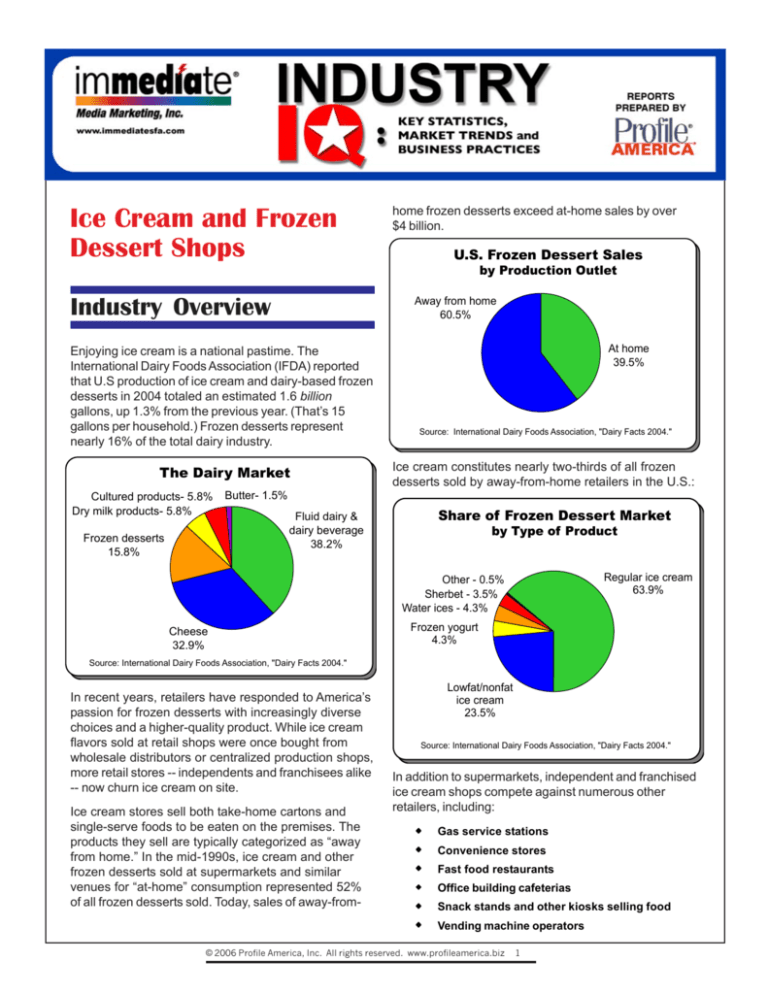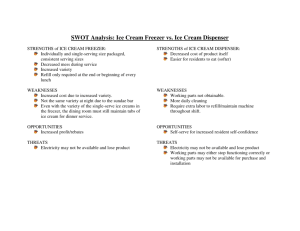
Ice Cream and Frozen
Dessert Shops
Industry Overview
The Dairy Market
Frozen desserts
15.8%
U.S. Frozen Dessert Sales
by Production Outlet
Away from home
60.5%
Enjoying ice cream is a national pastime. The
International Dairy Foods Association (IFDA) reported
that U.S production of ice cream and dairy-based frozen
desserts in 2004 totaled an estimated 1.6 billion
gallons, up 1.3% from the previous year. (That’s 15
gallons per household.) Frozen desserts represent
nearly 16% of the total dairy industry.
Cultured products- 5.8%
Dry milk products- 5.8%
home frozen desserts exceed at-home sales by over
$4 billion.
At home
39.5%
Source: International Dairy Foods Association, "Dairy Facts 2004."
Ice cream constitutes nearly two-thirds of all frozen
desserts sold by away-from-home retailers in the U.S.:
Butter- 1.5%
Share of Frozen Dessert Market
Fluid dairy &
dairy beverage
38.2%
by Type of Product
Regular ice cream
63.9%
Other - 0.5%
Sherbet - 3.5%
Water ices - 4.3%
Cheese
32.9%
Frozen yogurt
4.3%
Source: International Dairy Foods Association, "Dairy Facts 2004."
In recent years, retailers have responded to America’s
passion for frozen desserts with increasingly diverse
choices and a higher-quality product. While ice cream
flavors sold at retail shops were once bought from
wholesale distributors or centralized production shops,
more retail stores -- independents and franchisees alike
-- now churn ice cream on site.
Ice cream stores sell both take-home cartons and
single-serve foods to be eaten on the premises. The
products they sell are typically categorized as “away
from home.” In the mid-1990s, ice cream and other
frozen desserts sold at supermarkets and similar
venues for “at-home” consumption represented 52%
of all frozen desserts sold. Today, sales of away-from-
Lowfat/nonfat
ice cream
23.5%
Source: International Dairy Foods Association, "Dairy Facts 2004."
In addition to supermarkets, independent and franchised
ice cream shops compete against numerous other
retailers, including:
Gas service stations
Convenience stores
Fast food restaurants
Office building cafeterias
Snack stands and other kiosks selling food
Vending machine operators
© 2006 Profile America, Inc. All rights reserved. www.profileamerica.biz
1
Issues and Trends
Despite American’s penchant for tasty treats, ice cream
sales have been stagnant for the last few years.
According to Dairy Field (June 2005), actual gallonage
sales were down 1% in 2004. This reality, however, has
not dampened the optimism of those in the industry. The
fact is that more than 90% of Americans are ice cream
buyers, and the current market for ice cream is
estimated to be about $20 billion (Dairy Field, January
2005).
Other positive trends include increased production in the
industry. Regular ice cream production reached a new
record high of just over 1 billion gallons in 2003. Furthermore, low-fat and non-fat ice cream’s production volume
grew almost 4%, to nearly 374 million gallons (IFDA,
“Dairy Facts 2004”).
The growth in production of low-fat and non-fat ice cream
marks a trend in the industry in response to consumer
demand. An estimated 60% of mature Americans are
either dieting or planning to diet, and ice cream shops
around the country have been forced to include new
products in order to cater to this large percentage of the
population (Dairy Field, June 2005).
Luckily, innovation and technology have advanced to the
point where most low-fat and non-fat products are as
tasty as (or almost) full-fat products (Dairy Field, January
2005). More and more ice cream shops have recognized
this trend and have moved to incorporate healthy options
into their existing product offerings.
Aside from an increasingly health-conscious population,
ice cream shops have had to face a number of other
challenges, some of them are listed below:
When the cost of ingredients increases, it
forces retailers to raise prices. Vanilla extract,
for example, went from $60 to $238 a gallon
because of shortages resulting from floods in
Madagascar, Indonesia and Mexico. That crisis
subsided (The Washington Post, May 4, 2005),
but then milk prices increased because fewer
cows are producing it. Even those shops that
do not make their own ice creams have been
forced to charge more to accommodate
increasing supplier prices.
Energy prices. The cost of energy has impacted many small businesses, including even
small retail shops. Higher operating costs are
just the beginning. Many customers that would
otherwise patronize shops are also paying
higher fuel bills, which will cut into their level of
spending on “treats.”
Most ice cream shops do the bulk of their
business in the summer months, with some
businesses reporting that 70% of their annual
sales come occur May and the end of September. Because of this ebb-and-flow situation, it
is difficult for shops to maintain a full staff
during slow times and then build a knowledgeable staff up again in busier times.
Shop owners repeatedly cite weather as a
challenge to their success. In an atypically
rainy or cold year, sales plummet.
Competition with in-store ice cream products.
Americans are tempted by the many cartons
of ice cream available at their local grocer. In
fact, some stores have more than 17 doors of
ice cream of all types and prices available to
the everyday consumer. With a couple of
quarts of the frozen treat at home, consumers
are less likely to stop at a specialty shop.
Sources: The National Dipper, March April 2005; Dairy Field, January
2005; The Business Journal, June 10, 2005.
A number of successful chains specialize in ice cream
and frozen desserts. Some (like Dairy Queen and
Baskin Robbins) have been recognizable brands for
decades; others are newcomers to the industry.
Top Franchises in the U.S.
Franchise
# of Locations 2005
Dairy Queen
5,741
Baskin Robbins
5,124
Cold Stone Creamery
1,203
Ben & Jerry's
616
Dippin Dots
618*
TCBY
1,360*
Maggie Moos
167
Marble Slab Creamery
312
Haagen Dazs
240*
Source: Entrepreneur Magazine, “Top 500 Franchises,” January 2006.
* Indicates number of stores in 2004.
Though most of these top franchises are successful,
with recognizable brands and advertising campaigns, the
industry is dominated by small local family-owned
chains or one-location independent shops -- many of
which are successful in their own right. Amy’s Ice
Creams, Inc., for example, which has 10 locations in
Texas, reported that its revenue reached around $4.5
million (Austin Business Journal, October 29, 2004). The
Blue Sky Creamery, in Minnesota, said it expects 2005
revenue from its single location to hit $500,000 (The
Business Journal, June 10, 2005).
© 2006 Profile America, Inc. All rights reserved. www.profileamerica.biz
2
In its “Industry Outlook,” The National Dipper interviewed
a number of independent store owners, all of whom
reported solid gains in 2004. While some saw greater
gains than others, all were pleased with the state of
affairs and expressed optimism about the near-term
outlook (March/April 2005).
Most small shops need to stand out from the crowd and
convince customers that theirs is a shop worth visiting.
Consumers typically visit ice cream and frozen treat
shops not only for the ice cream or frozen treat, but for
the experience. Small shops should look to make that
experience uniquely entertaining in order to promote
return visits (The National Dipper, March/April 2005).
One way stores have created a satisfying experience is
by providing a family-friendly atmosphere. The “oldfashioned, family-style” concept has proven successful
for a number of small shops (Orlando Business Journal,
January 7, 2005). Other shops have added a “wacky”
element to everything from their flavors’ names to their
employees’ attire (Austin Business Journal, October 24,
2004).
Ensuring that customers have a positive in-store
experience is an important element in the overall formula
for success, especially since happy customers tend to
become repeat customers. Attracting new customers is
also vitally important, so shops use a variety of
advertising vehicles to build awareness. In addition to a
growing tendency to create websites to tout their
products and educate or motivate consumers, the most
commonly used ad media, according to IFDA’s “Dairy
Facts 2004,” include the following:
Newspapers
Local magazines
Local television, including cable
Yellow Pages
Radio
Direct mail
Billboards and other signage
Ice creams made with premium ingredients, such as
seasonal fruits or high-quality chocolates, typically cost
around $4 for a single serving. Ice cream cakes (e.g.
those sold by Carvel, Baskin Robbins, and Cold Stone
Creamery), sell for $18 to $40, depending on the size
and the design work that goes into the cake.
Critical Success Factors
CSFs for Frozen Dessert Shop
Owners and Operators
Self promote. Often the best way to promote a
small ice cream shop is to let other people
know directly how great the product is (e.g.,
providing samples and coupons to passers-by
and neighboring merchants).
Allow passion to show in the product. Offer
high-quality ice cream and other treats with
original, fun flavors.
Promote value over price. Often the value of
the product will outweigh the price; a product
can be so good that customers do not mind the
price.
Get customers’ contact information. Keeping
in touch with customers is a good way to
encourage them to return.
Make customer service the priority. Greet
customers as soon as possible. Gladly provide
sample tastes. Give away the occasional cone
at no cost to help engender loyalty.
Change things up in the store. Create new
flavors and/or product offerings. People are
more likely to make unplanned stops if they
know the store’s offerings are likely to change.
Sources: The National Dipper, May 2004, May/June 2005; Orlando
Business Journal, January 7, 2005, Baltimore Business Journal, March
18, 2005.
Industry Resources
Value of Products and
Services in the Industry
Average household spending on away-from-home ice
cream is around $114 ($12.5 billion divided by 122
million households).
According to an article in The Boston Globe (May 23,
2004), the average price of an ice cream cone rose 35 to
45 cents, due ingredient cost increases. Most ice cream
cones cost between $1.50 (for a small) and $3.25 (for a
large, or double scoop).
International Dairy Foods Association
International Ice Cream Association
1250 H Street N.W., Suite 900
Washington, D.C., 20005
202-737-4332
www.idfa.org
The National Dipper
1841 Hicks Road, Suite C
Rolling Meadows, IL 60008
847-202-4770
www.nationaldipper.com
Ice Cream Reporter
7 Hilton Terrace
Willsboro, NY 12996
518-963-4333
© 2006 Profile America, Inc. All rights reserved. www.profileamerica.biz
3
Background
Values and Benefits
Media Marketing, Inc., creators of imMEDIAte®
software, has been in the forefront of sales
presentation systems since 1987. The imMEDIAte
suite, a state-of-the-art consultative system, is
used by hundreds of media reps every day to
create compelling presentations and expert
media proposals. Built on Microsoft Office®
technology, the imMEDIAte system provides a
complete solution to your media sales needs.
Media Marketing is an authorized distributor of
Profile America’s IndustryIQ reports. Sales and
marketing teams embrace these industryknowledge reports because of their concise,
easy-to-read style and rich store of information.
Regular use of IndustryIQ reports creates a
relationship-building, consultative environment.
Sales reps want to be smart about advertisers’
industries, but face the realities of limited time
and resources. They need to track dozens of
different industries, and value these concise,
easy-to-use sales tools that they can leave
behind with their advertisers.
Likewise, managers want reps to be confident,
professional and informed. They want their
reps viewed as partners, not vendors -- and
they appreciate the IndustryIQ method of
collecting, analyzing and presenting
information.
Independent, third-party IndustryIQ reports
leave marketing and sales professionals free
to practice their core competencies:
developing successful advertising strategies
for their clients.
Since 1986, Profile America has provided
profiles of industries, markets and trends to
business-to-business marketers, facilitating an
understanding of the industries into which they
sell their products and services.
Program Objectives
IndustryIQ reports are used by managers as
sales training, planning and business
development tools. Sales reps use IndustryIQ
reports to prepare for sales calls and as a
valuable leave-behind.
Armed with independent, third-party
assessment of industry dynamics, media reps
can “walk the walk and talk the talk” of their
advertisers’ industries, allowing reps to better
assist advertisers in creating compelling,
effective messages for their target audiences.
Delivery
IndustryIQ reports incorporate a customerguided approach to gathering information and
creating industry-knowledge products. We
value your content recommendations as we
strive to create the most useful, fact-filled
industry reports available.
IndustryIQ reports are available in PDF format
from Media Marketing’s web site,
www.immediatesfa.com.
IndustryIQ is distributed by Media Marketing, Inc. in association with Profile America, Inc. for use by advertising sales representatives.
Although the information in this report has been obtained from sources that Profile America, Inc. believes to be reliable,
no guarantees are made as to the accuracy of the information presented, and any information presented may be incomplete or condensed.
© 2006 Profile America, Inc. All rights reserved. www.profileamerica.biz
4







